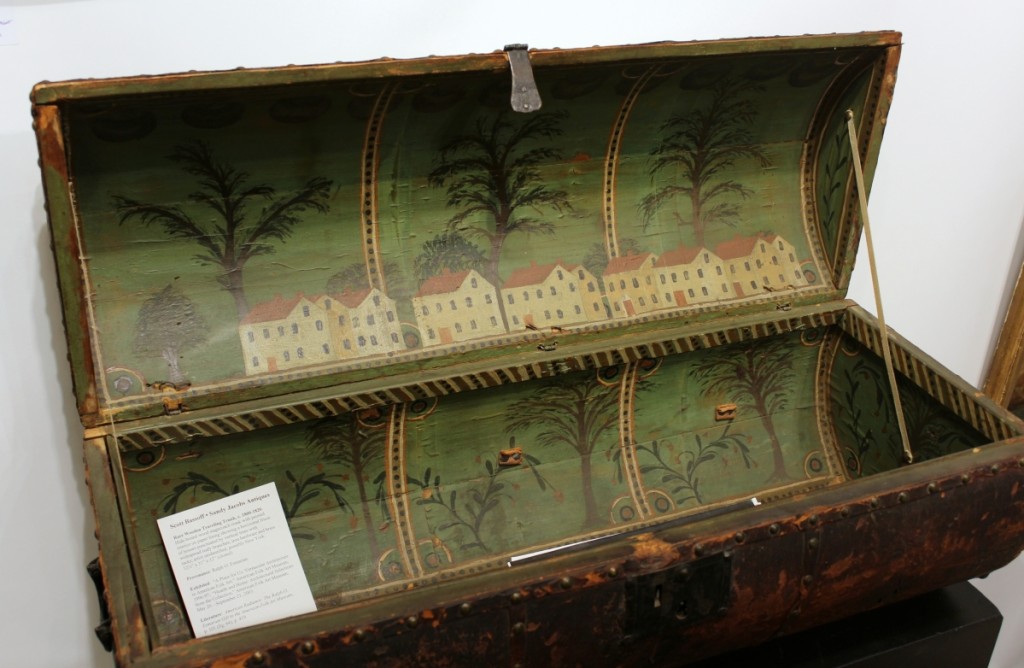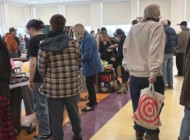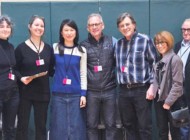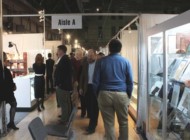Review and Onsite Photos by Madelia Hickman Ring
WASHINGTON DC – The 65th Washington Winter Show was conducted January 10-12 at the Katzen Arts Center on the campus of American University. Balmy temperatures provided a marked contrast to the previous edition, which prevailed despite a government shutdown and frigid temperatures. Some dealers noted that sales seemed down, which many attributed to the unseasonably warm weather.
Presented by PNC Wealth Management and benefitting the Bishop John T. Walker School for Boys, THEARC and The Founders Board of St John’s Community Services, the show had a full program of events. British architectural and interior designer, Ben Pentreath’s keynote lecture, “Designing to the Rhythm of Time,” enlivened a luncheon on the first morning of the show. A panel featuring designers Barrie Benson, Lauren Liess and Tom Scheerer, moderated by Whitney Robinson, was the first order of business on Saturday, January 11. Late that afternoon, Winterthur’s director of external affairs, J. Thomas Savage, presented, “More Than America’s Treasure House: Henry Francis DuPont’s Winterthur,” which got attendees in the mood for Jazz Night.
“I think overall it went really well. The attendance was really good, and people were shopping,” said show manager, Karen DiSaia, speaking with Antiques and The Arts Weekly by phone after the show. She noted that attendance for both the Opening Night and Jazz Nights were on par with previous years but thought that the academic nature of the lecture on Saturday might have contributed to increased attendance.
“Icons of America, Washington and Beyond” was the title of the loan exhibition, which featured selections from Winterthur Museum, Library and Gardens in Wilmington, Del. Many dealers brought works featuring George Washington to tempt buyers, some advertising them in the catalog to the show, which was a successful strategy, with several dealers reporting sales of Washington-themed fine and decorative arts.
The show welcomed eight new exhibitors to the floor, with several dealers moving into spaces they had not previously occupied. Dealers making their debut were: Georgian Manor Antiques, J&M Antiques, Pagoda Red, Rayon Roskar, Michael Weinstein/Artifacts, Judith & James Milne / At Home Antiques, Glen Leroux Antiques and Nula Thanhauser.
 “I had a very good show but I also credit that to a new location and almost every purchase was a new client,” was the comment from Taylor Thistlethwaite, Thistlethwaite Americana, who occupied the booth closest to the front door and enjoyed foot traffic from the moment the doors opened. Within the first 15 minutes on Opening Night, Thistlethwaite had sold ten pieces of lusterware displayed in a corner cupboard, and by the end of that night, he had sold a pair of landscape paintings by Washington DC artist, Garnet Jex (1895-1979). Reporting “consistent sales throughout the weekend,” he also reported selling a folk art still life that had been in the collection of Pam Boynton, a Malachite rug by Tony Duquette and a mezzotint of George Washington, among other sales.
“I had a very good show but I also credit that to a new location and almost every purchase was a new client,” was the comment from Taylor Thistlethwaite, Thistlethwaite Americana, who occupied the booth closest to the front door and enjoyed foot traffic from the moment the doors opened. Within the first 15 minutes on Opening Night, Thistlethwaite had sold ten pieces of lusterware displayed in a corner cupboard, and by the end of that night, he had sold a pair of landscape paintings by Washington DC artist, Garnet Jex (1895-1979). Reporting “consistent sales throughout the weekend,” he also reported selling a folk art still life that had been in the collection of Pam Boynton, a Malachite rug by Tony Duquette and a mezzotint of George Washington, among other sales.
Opposite Thistlethwaite, Ron and Joyce Bassin of A Bird in Hand Antiques had brought a great selection of weathervanes, Grenfell mats and decoys, in addition to a bronze profile of George Washington mounted on an oak board from the late Nineteenth Century. Among the highlights Ron Bassin happily pointed out was a painting of the ship Benjamin C. Cromwell by William P. Stubbs, a Cushing and White “Smuggler” running horse weathervane, a few sandpaper drawings, including a small one rendering the Hudson River at West Point in exquisite detail and a group of shorebird decoys featured in Henry Stansury’s book, Lloyd J. Tyler Folk Artist Decoy Maker. The Bassins ended up having a good show, selling a variety of object “to a receptive and knowledgeable audience.” Sales included a pair of folk art bird lamps, two paintings, a bronze dog, a tramp art pedestal and a Shenandoah Valley painted corner shelf.
Kevin Garvey Rita shared an eclectic booth with Bruce Emond of Village Braider. When asked, Rita pointed out a color woodcut by Margaret Jordan Patterson (1867-1950) titled “Flowers,” which he described as a “classic example” of her work but with unusually bright original colors. Rita had acquired it shortly before the show and it was the first outing for the work. After the show, Rita said it had been a good show for him after a slow start, including sales to a younger demographic. “The Washington show is quite unique, in my opinion, from other shows. It gets an international audience and the show committee has lots of young people on it, who generate buzz among themselves and their friends. It has a kind of energy other shows do not.”
Standing out – literally – from the rest of the booth was an impressive looking Egyptian Renaissance semi-nude figure carved from white marble that had provenance to the Newport, R.I., mansion, The Oaks. Other pieces of interest included a Japanese trade sign, a pair of garden urns, a Southern cellarette and a glass patio table with four chairs. Speaking after the show, Bruce Emond said the show was “OK” for him. He sold the Southern cellarette to a young collector on the first day, as well as an Italian table, a cupboard and lots of smalls, to name a few of his sales.
Thistlethwaite was not the only dealer on the first floor to sell immediately. Showgoers were two deep at the jewelry case fronting newcomer Nula Thanhauser’s booth, where the New York City dealer was spotted busily writing receipts for people jockeying for her jewelry and handbags. Kitty-corner from Thanhauser, Prisilla Boyd Angelos of Boyd’s Antiques was busy wrapping blue and white porcelain for a buyer. After the sale, Angelos said “I did have a great show, with about 50 sales but not big-ticket items. I sold across the board: lamps, set of four chairs, drop leaf table, etagere, chest, silver, porcelain, brass, etc. The show committee, manager, and event planner do an unreal job of bringing a lot of the right people to the show. They work really hard to make the show a huge success.”
-553x1024.jpg)
Gary Sergeant had this mid-Nineteenth Century portrait of George Washington painted by an artist after Gilbert Stuart’s portrait that was commissioned by Samuel Vaughan. It looked right at home above a George III serpentine mahogany chest. G. Sergeant Antiques, Woodbury, Conn.
“It’s such a unique show with diverse merchandise. I love going there and being a part of it,” was Sandy Jacobs’ post-show comment, who followed up with Antiques and The Arts Weekly via email. Characterizing it as “a good show,” some of the sales she reported was an early painting of George Washington, a pair of carved snakes, children’s mugs and fine jewelry. Jacobs had a first-time customer of memorial jewelry who bought it despite knowing nothing about it and who wanted to learn.
David Brooker brought mid- to late Nineteenth Century British paintings, as well as Seventeenth Century European paintings, selling about 15 works during the show, including a beach scene by Lucien Adrian he had snapped up at Brimfield. He noted he did very well selling to new clients, commenting that many were well under 50 years of age, an age group he “hasn’t seen in shows for a long while.” Brooker also had a good selection of modern and contemporary works, including several collaged works by Claude Howard Stuart, which he did not sell, despite “massive interest.”
Exhibiting at the show for the first time, James and Judith Milne / At Home Antiques seemed right at home tucked into a corner on the first floor. Prominent among their weathervanes, quilts, folk paintings and painted furniture were numerous food signs and doorstops, both of which Judith Milne said had all come from the same collection.
Bev and Doug Norwood had taken the theme of the loan exhibition to heart, creating an homage to George and Martha Washington on one wall that included a printed textile, Thomas Clarke’s 1801 stipple and line engraving, a mourning picture, a bust of George Washington and a small profile portrait of Martha Washington on one wall, with a polychromed bas-relief of Washington topping an adjacent wall.
Think being next to the bar is a bad thing? Think again! Charles Edwin Puckett’s booth of maps, medieval manuscripts and Classical antiques saw busy traffic, largely in part to being so close to the bar. “The show was very good, we were very active, particularly on Saturday. There seemed to be more of a younger demographic come through. We haven’t had enough younger new clients and we got some this time,” Charles Puckett said after the show, who said younger buyers bought some antique maps and medieval manuscripts. Other sales included a 1755 Fry-Jefferson map of Virginia as well as other maps and prints related to the George Washington theme while coins were among the antiquities sold.
Gary Sergeant’s booth on the second floor prominently displayed a portrait of George Washington after Gilbert Stuart’s “Vaughn” portrait. It was one of a few works depicting Washington with the Woodbury, Conn., dealer, who also had a French mantel clock with a George Washington figure attributed to Louis Mallet, circa 1820; and a Jeremiah Paul Jr painting of the Washington family. After the show, Sergeant said he had had “lots and lots of interest” with a few sales and more potential sales pending, which would make it a great sale for him. He noted in an email that “people were a bit more enthusiastic than the past few shows we’ve done.”
Tim Brennan and Dave Mouilleseaux of Period to Mod could not have a more different look from the formality of Sergeant’s booth. Combining older and newer pieces, including folk art and garden pieces, the Briarcliff Manor, N.Y., dealers booth juxtaposed a framed Bill Traylor exhibition posted over a tall chest of drawers, overstuffed furniture in front of rusticated console tables and four Federal shield-back chairs around a pedestal supporting a large garden urn. By the end of Opening Night, the rusticated console table had sold, as had a few framed pages from a 1939 typography design book.
Bob Haneberg said he and Claudia had a “very good show,” selling items across the board, including silver, China trade paintings, American art, Chinese porcelain, American furniture, miniature furniture and candlesticks. Adjacent to the Hanebergs, Paul Vandekar and Deidre Healey of Earle D. Vandekar of Knightsbridge had a large selection of English ship “woolies,” framed botanicals and porcelains in a dizzying array of ages, styles and price points. Healey pointed out one of her favorite items, a circa 1830-40 English 22-piece dessert service, possibly by Davenport, with trompe l’oeil leaf-decoration. After the show, Paul Vandekar said the service had sold and reported a few sales were pending, including “one to an important local institution.”
Beck’s Antiques featured a folk art oil on canvas mid-Nineteenth Century painting depicting the tomb of Washington at Mount Vernon, which Bill Beck said had “lots of people talking.” It did not sell at the show, though Beck did report selling “mostly smalls, particularly jewelry. Only one piece of furniture and a couple of rugs.” Beck commented that the show seems to be drawing a “surprisingly young and enthusiastic crowd. I’m sure that is attributable to the committee’s effort at special events. My very last sale, five minutes after closing, was a nice little George Washington portrait to a young lady who couldn’t have been much past college age.”
Carole Pinto is working to create a market for American and French artists who studied with some of the icons of French Impressionism but whose names are not as well known and whose works are more affordable. Pinto only acquires the best examples she can find, and does her own authentication, research, framing and restoration. She reported strong interest throughout the weekend and sold a landscape by Louis Neillot (1898-1973); a few sales were pending when Antiques and The Arts Weekly caught up with her after the show.
-1024x608.jpg)
Two impressive clocks with Gates Antiques Ltd, were, on the left, a Queen Anne long case clock with marquetry veneer and a dial inscribed “Esaye Fleureau made on Long Acre Street in London.” On the right, a Scottish George III mahogany long case clock with a brass dial engraved “Ja Liddle Parkhead.” The Welsh cupboard at the right was laden with Chinese export porcelain in the Imari and Rose Medallion patterns. Midlothian, Va.
A hooked staircase runner, a painted leather Asian screen depicting birds and a circus banner promoting a “Gigantic Pig” were among the more unusual items with Find Weatherly, LLC. In a post-show email, Ann Wilbanks said the pig banner resonated with a lot of attendees and was on the list for the kids’ “Sundaes on Sunday” scavenger hunt. By the end of the show, Wilbanks had sold it to a man who collects pig art. She also sold the painted leather bird screen and a few other things.
“The show in general was great. I met new customers who purchased from me, which is always good, and I had returning customers who also purchased, so all in all, wonderful,” was AJ Warren’s comment. Maria and Peter Warren Antiques was in a new location this year, a move that apparently resonated with clients: “We also received many compliments on our booth, which are always nice to hear and nice and to have.”
Several new exhibitors were on the third and top floor of the show. Pagoda Red from Chicago featured antique and vintage Asian items, all artfully arranged, including a circa 1750 Edo festival screen that lined the wall leading into the booth. Next to them, Georgian Manor Antiques specializes in British design and history and proprietor Enrique Goytizolo had filled a gleaming booth with small furniture, pictures and decorative items. Westport, Conn., dealer Glen Leroux, who specializes in Midcentury Modern and Twentieth Century decorative arts and jewelry, said he had made several nice sales, most of which were jewelry.
Rayon Roskar said he is the only dealer in the United States specializing in Twentieth Century Swiss design. His booth combined Swiss design with French and Italian, headlining a 1971 modernist floor lamp from the Ciby-Geigy Pharmaceutical headquarters in Basel, Switzerland. His wife, Ellie Kim, also pointed out a Willy Guhl bibliotheque that had been recently acquired. In a post-show email, Roskar said, “The show is easily the best attended show we have participated in to date,” adding that he had sales that carried their booth, and the exposure at the show was beneficial at gauging the Washington market and interest. He thought a larger component of modern design at the show would benefit him in future years.
The showstopper in the booth of Greenville, Del., dealer Jim Kilvington was a Rhode Island block and shell-carved chest of drawers, circa 1765, that Kilvington said had been restored. By the end of the Opening Night party, red sold stickers were spotted on a set of four Crichton Brothers candlesticks. After the show, Kilvington characterized it as “good,” with “normal” sales.

Sandy Jacobs had this wooden traveling trunk with painted-paper interior that had been in the Ralph Esmerian collection. Scott Bassoff, Sandy Jacobs Antiques, Swampscott, Mass.
For dramatic effect, one needed to look no further than the balloon-like inflatable globe that fronted the booth of the Philadelphia Print Shop West. Christopher Lane said he had acquired Pocock’s 1830 globe shortly before the show. Made in three sizes, this being the largest with a 48-inch diameter, the fragility and impracticality of such globes likely resulted in poor sales at the time and this example is a rare survivor. Reached for comment as he was driving back to Colorado, Lane said that the show was beautiful, and his booth saw lots of interest.
D.M. DeLaurentis Fine Antique Prints brought a broad selection to appeal to every taste and wallet, from sporting prints to botanicals and costume plates. One wall was dominated by eight sporting prints by A.B. Frost, for which the Doylestown, Penn., dealer was asking $1,850 apiece. DeLaurentis’ homage to George Washington included an engraving after John Trumbull’s portrait of Washington at Trenton. On the night of the preview party, DeLaurentis had sold three Seventeenth Century botanical prints.
Nineteenth and early Twentieth Century European art is the bailiwick of Ken Kelleher of Kelleher Fine Art, which travels the greatest distance to this show from any gallery in the United States. The Turlock, California-based dealer said he brings a good mix of traditional and contemporary art to Washington, where he finds a cosmopolitan clientele that can appreciate both. Blank spots on his wall were seen towards the end of the evening of the Opening Night, suggesting his inventory was resonating with clients.
Next to Kelleher, W.M. Schwind Jr had formal American furniture, paintings, hooked rugs, porcelains and glass, as well as jewelry. Speaking after the show by phone, Jeffrey Schwind said the show was “pretty good. We sold a little bit of everything.” While he had no young buyers, and most of his sales were to existing clients, they did have a few new clients. Schwind reported selling two of three Nineteenth Century ceramic works featuring George Washington from their show advertisement: a plate and a pitcher.
Across the aisle from the Schwinds, Roger Winter’s large sprawling booth featured primarily Eighteenth and early Nineteenth Century English antiques, including an impressive late Nineteenth Century bird’s-eye maple partners’ desk. Characterizing the show as “fair,” with “a decent crowd,” Winter reported selling several things, including a Marlborough George III armchair and a palace-size Coromandel Screen that he had featured in his show catalog advertisement.
-1024x669.jpg)
This Rhode Island Chippendale block and shell-carved chest had restoration and was with James M. Kilvington, Greenville, Del.
Want to buy an antique that has some Hollywood glamour? Go see John “Jay” Gates III at Gates Antiques, Ltd, who said a good part of the firm’s business since the 1980s is renting out furniture as props for movies that film in Virginia. He rattled off a number of movies his firm has sourced furniture for, including Harriet, The Good Lord Bird, the miniseries North and South, Lincoln, Sommersby and The Jackal. After the show, Gates said it had been the best Washington Winter show in years, selling to both established and new customers.
Carole Pinto was not the only dealer to sell the piece featured in the show catalog. Jasmine Doussiere of Silver Art by D&R sold a silver and crystal French centerpiece by Peirre Queille, circa 1850s, as well as sugar bowls, first Empire silver pieces, French drawings, decorative pieces and animalier bronzes by Antoine Louis Barye. When reached for comment after the show, Doussiere said, “It was a very good show for us. The Washington DC clientele is extremely keen on historical background and we find that they like to hear about the differences between French and American as well as British silver.”
The 66th annual Washington Winter Show will take place January 8-10, with an Opening Night party on Thursday, January 7. For more information, www.washingtonwintershow.org.

-1024x504.jpg)
-1024x682.jpg)

.jpg)
.jpg)
.jpg)
.jpg)
.jpg)
.jpg)
.jpg)
.jpg)
.jpg)


.jpg)
.jpg)
.jpg)
.jpg)
.jpg)
.jpg)
.jpg)
.jpg)
.jpg)
.jpg)
.jpg)
.jpg)
.jpg)
.jpg)
.jpg)

.jpg)
.jpg)
.jpg)
.jpg)
.jpg)

.jpg)
.jpg)
.jpg)

.jpg)
.jpg)
.jpg)
.jpg)
.jpg)
.jpg)
.jpg)
.jpg)
.jpg)
.jpg)
.jpg)
.jpg)
.jpg)
.jpg)
.jpg)
.jpg)

.jpg)
.jpg)



